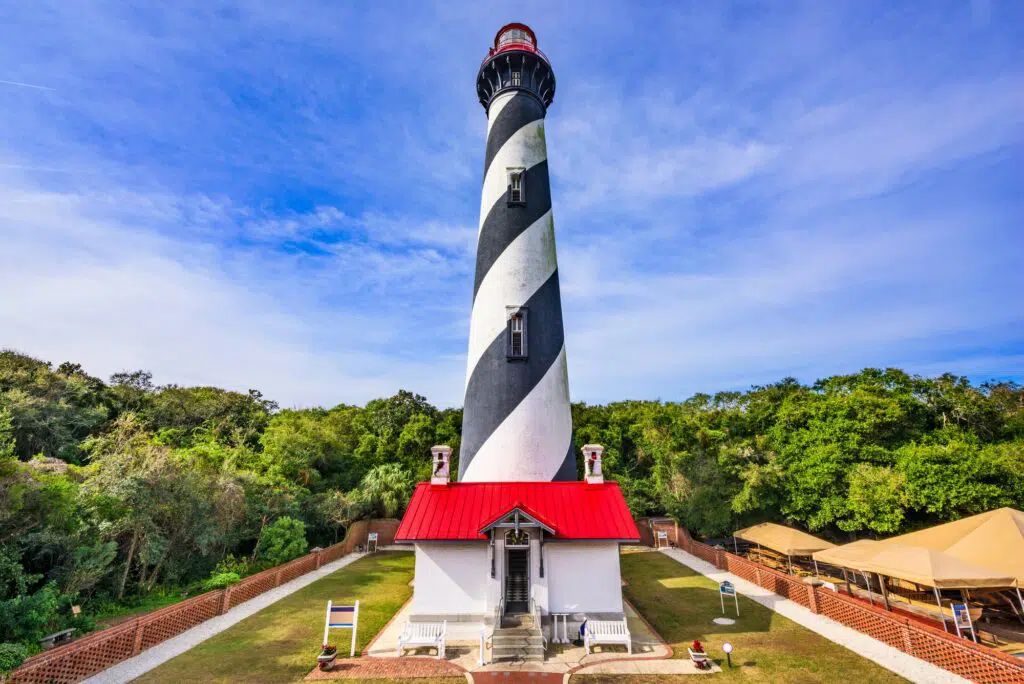An integral part of the history of Florida is its maritime heritage that dates back thousands of years. Around 2400 BC, Native Americans began to occupy what is now modern-day Florida. As a loose amalgamation of tribes that shared a common language, the Timucua were not bound politically as a common people. While they traded with each other, they also fought with one another. Eventually, in the location of present-day St. Augustine, they built a Timucuan village which they named Seloy after their principal chief.
Constructed of thatched palm, their houses were usually circular. The Timucua used various implements and ornaments made of bone, shell, stone, and wood. They fished, hunted, and cultivated corn, beans, and squash. However, their centuries of peaceful living were about to be shattered, when in the 16th century, European explorers brought a severe clash of cultures to their shores.
The History Of Florida Changes Course
In April 1513, the history of Florida took a different course. The renowned Spanish explorer Juan Ponce de Leon landed on the coast while searching for the fabled isle of Bimini. Apparently, the landing spot where Ponce and his men came ashore was between Cape Canaveral and the St. Johns River mouth. While looking for this exact spot, archeologists have conducted numerous digs at the Fountain of Youth. This National Archeological Park is where the Timucuan village of Seloy was located, and the city of St. Augustine first began.
Ponce de Leon’s mission was to explore, not settle, so his visit to northeast Florida was not long. Ponce named his new discovery La Florida because he arrived during the Easter season, known in Spain as the Pascua Florida, and this is the name that is still used today.
Improving Travel From Florida To Spain
Besides claiming the land for Spain, Ponce de Leon made a discovery that was to lead to the creation of St. Augustine. Sailing along the Florida coastline, he realized that a strong current was carrying his ships rapidly northward. This would help Spanish ships return home quickly and was later named the Gulf Stream.
After it runs through the Straits of Florida, the stream continues up the eastern seaboard and turns west towards Europe, just off the coast of St. Augustine. Spanish colonies in South and Central America took advantage of this natural shipping route, carrying naval stores, gold, silver, and foodstuffs home to Spain.
The Spanish Overlook Florida
After Ponce de Leon, other Spanish explorers like Tristan de Luna, Cabeza de Vaca, and Hernando de Soto visited Florida. However, they all agreed that it would not be worthwhile to invest in this land. It was a dangerous environment with alligators, snakes, and insects. The heat and humidity were as unforgiving as were the hurricanes and other storms.
There were areas of Florida that welcomed the Spanish. However, they soon realized that it would be no easy task to subdue the war-like native population. In other parts of the New World, the local native tribes could be forced into slave labor while Spain took their gold and silver. What’s more, European-style agriculture did not work well on the coasts, and as a result, a colony in Florida would have to depend on help from Spain to survive. Based on these factors, the Spanish simply ignored risky Florida.
The French Influence The History Of Florida
In 1562, Huguenot explorer Admiral Jean Ribault and Rene Goulaine de Laudonniere established two French colonies. One was at Charlesfort and the other, Fort Caroline, was near present-day Jacksonville. Here, the Huguenots enjoyed religious freedom, but they ran out of provisions, and discontent followed. In December 1564, sixty soldiers from Fort Caroline stole two barks (ships) and seized food from the Spanish, which angered them greatly.
In mid-August 1565, Ribault arrived at Fort Caroline with supplies, colonists, soldiers, and artillery. However, before he could unload, Pedro Menéndez de Avilés arrived with his Spanish ships. After some nasty verbal exchanges and gunfire, the Spanish withdrew to the south, where they made land at St. Augustine.
Ribault quickly followed Menéndez, blocked the inlet, and demanded that the Spanish surrender to him. But fate took a cruel twist when a tremendous hurricane arose. It swept the French ships out to sea, and they were wrecked near Cape Canaveral, and Renault’s flagship Trinite was destroyed. Menéndez then marched 30 miles through the storm to Fort Caroline and killed 130 Huguenot settlers. Four French ships remained in the harbor. Two were sunk and managed to depart with a group of 100 survivors, which included Laudonnière. Menéndez then marched south, where he put to death two more groups of shipwreck survivors, including Ribault, near Matanzas Inlet.
The Spanish Settle In Florida
In September 1565, Chief Seloy of the Florida Timucua met with Menéndez. He agreed to allow Menendez and 800 colonists to settle at his village and use his council house as the first Spanish fort. The Spanish group included 24 women and an unknown number of African slaves. The Spanish proceeded to build a series of watchtowers along the coast. From these lookouts, sentries kept watch on the ocean and could warn of approaching ships. For this purpose, they kept canoes nearby to allow the sentries to warn the town.
The first of these 16th-century island Spanish watchtowers would become the St. Augustine Lighthouse. To this day, this tower serves as a reminder of the critical role played by the Spanish in the history of Florida.
